
Gamla stan, until 1980 officially Staden mellan broarna, is the old town of Stockholm, Sweden. Gamla stan consists primarily of the island Stadsholmen. Officially, but not colloquially, Gamla stan includes the surrounding islets Riddarholmen, Helgeandsholmen and Strömsborg. It has a population of approximately 3,000.
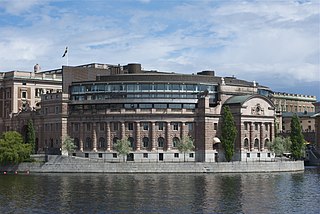
Helgeandsholmen is a small island in central Stockholm, Sweden. It is located north of Stadsholmen, and east of Strömsborg, with which, together with Riddarholmen, it forms Gamla stan, the old town of Stockholm. Helgeandsholmen contains the Riksdag Building and the Museum of Medieval Stockholm, and is connected to neighbouring islands through three bridges: Riksbron, Stallbron, and Norrbro. Despite the small size, it's very important as it contains the parliment building, where the Prime Minister is.

The Bonde Palace is a palace in Gamla stan, the old town in central Stockholm, Sweden. Located between the House of Knights (Riddarhuset) and the Chancellery House (Kanslihuset), it is, arguably, the most prominent monument of the era of the Swedish Empire (1611–1718), originally designed by Nicodemus Tessin the Elder and Jean De la Vallée in 1662-1667 as the private residence of the Lord High Treasurer Gustaf Bonde (1620–1667) it still bears his name, while it accommodated the Stockholm Court House from the 18th century and since 1949 houses the Swedish Supreme Court. On the south side of the building is the street Myntgatan and the square Riddarhustorget, while the alleys Riddarhusgränd and Rådhusgränd are passing on its western and eastern sides.

Kungsträdgården is a park in central Stockholm, Sweden. It is colloquially known as Kungsan.

Kungsholmen is an island in Lake Mälaren in Sweden, part of central Stockholm, Sweden. It is situated north of Riddarfjärden and considered part of the historical province Uppland. Its area is 3.9 km2 (1.5 sq mi) with a perimeter of 8.9 km (5.5 mi). The highest point is at Stadshagsplan at 47 metres (154 ft). The total population is 71,542.
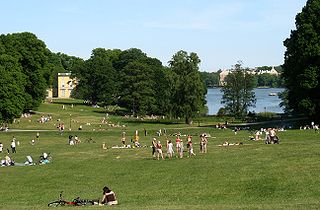
Hagaparken, or simply Haga in Solna Municipality just north of Stockholm, Sweden, is a vast and popular nature area, with large lawns, woods and gardens.
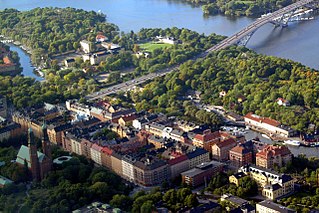
Långholmen is an island between two other islands, Södermalm and Kungsholmen, in central Stockholm, Sweden. This island can be reached via two bridges; Pålsundsbron in the east and Långholmsbron in the west. Långholmen is a popular spot for walks, picnics and swimming. The small beaches, located right outside the former prison, are usually crowded in summer.

Ulriksdal Palace is a royal palace situated on the banks of the Edsviken in the Royal National City Park in Solna Municipality, 6 km north of Stockholm. It was originally called Jakobsdal for its owner Jacob De la Gardie, who had it built by architect Hans Jacob Kristler in 1638–1645 as a country retreat. He later passed on to his son, Magnus Gabriel De la Gardie, from whom it was purchased in 1669 by Queen Hedvig Eleonora of Sweden. The present design is mainly the work of architect Nicodemus Tessin the Elder and dates from the late 17th century.

Blackamoor is a type of figure and visual trope in European decorative art, typically found in works from the Early Modern period, depicting a man of sub-Saharan African descent, usually in clothing that suggests high status. Common examples of items and objects decorated in the blackamoor style include sculpture, jewellery, and furniture. Typically the sculpted figures carried something, such as candles or a tray. They were thus an exotic and lightweight variant for the "atlas" in architecture and decorative arts, especially popular in the Rococo period.
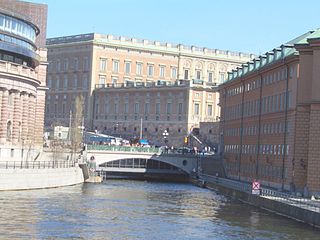
Stallbron is an arch bridge located in Gamla stan, the old town in central Stockholm, Sweden. Stretching some 20 meters over Stallkanalen it connects Riksgatan passing through the Parliament Building on Helgeandsholmen to the square Mynttorget on Stadsholmen from where Västerlånggatan extends it further south.

Strömsborg is a small islet in central Stockholm, Sweden, located north of Stadsholmen, and west of Helgeandsholmen, between the bridges Centralbron, a motorway passing through central Stockholm, and Vasabron. Administratively, Strömsborg is part of Gamla stan, the old town of Stockholm and is connected to the rest of the city by the bridge Strömsborgsbron leading over to Vasabron.

Trädgårdsgatan is a small street in Gamla stan, the old town of Stockholm, Sweden. It stretches west from Skeppar Olofs Gränd to Källargränd, just south of the Royal Palace and north of the square Stortorget. Forming a parallel to Slottsbacken and Köpmangatan, it is intercepted by Trädgårdstvärgränd. On the northern side of the street are gates leading to Bollhustäppan. It is named after the royal gardens once located along its northern side.

Slottsbacken is a street in Gamla stan, the old town in central Stockholm, Sweden.

Lejonbacken is a system of ramps leading up to the northern entrance of the Royal Palace in Stockholm, Sweden. They were built during the 1780s named after the pair of sculpted Medici lions prominently exposed on the stone railings of the ramps.
Riddarhustorget is a public square in Gamla stan, the old town in central Stockholm, Sweden, named after its location in front of the House of Knights (Riddarhuset).

Igelbäcken is a small stream in northern Stockholm, Sweden. The drainage area, part of the Royal National City Park and divided into several nature reserves, is shared by the municipalities of Järfälla, Sollentuna, Solna, Stockholm, and Sundbyberg.

Karlberg Palace is a palace by the Karlberg Canal in Solna Municipality in Sweden, adjacent to Stockholm's Vasastaden district. The palace, built in 1630, today houses the Military Academy Karlberg.
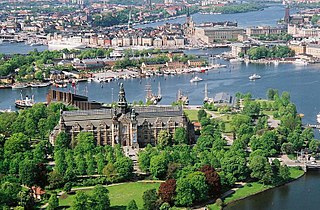
Djurgården or, more officially, Kungliga Djurgården, is an island in central Stockholm, Sweden. Djurgården is home to historical buildings and monuments, museums, galleries, the amusement park Gröna Lund, the open-air museum Skansen, the small residential area Djurgårdsstaden, yacht harbours, and extensive stretches of forest and meadows. It is one of the Stockholmers' favorite recreation areas and tourist destinations alike, attracting over 10 million visitors per year, of which some 5 million come to visit the museums and amusement park. The island belongs to the National City park founded in 1995. Since the 15th century the Swedish monarch has owned or held the right of disposition of Royal Djurgården. Today, this right is exercised by the Royal Djurgården Administration which is a part of the Royal Court of Sweden.

Solna Church is a so-called round church in Solna Municipality near Stockholm, Sweden. It is part of Solna Parish in the Diocese of Stockholm. The church is located on the headland between Brunnsviken and Ulvsundasjön, at the southern end of the cemetery Norra begravningsplatsen. The oldest parts of the church are from the later 12th century, a Romanesque fortress church built in stone.

Georg Theodor Policron Chiewitz was a Swedish architect and engineer. Due to financial problems he moved to Finland in 1851, where Chiewitz spent the rest of his career.




















